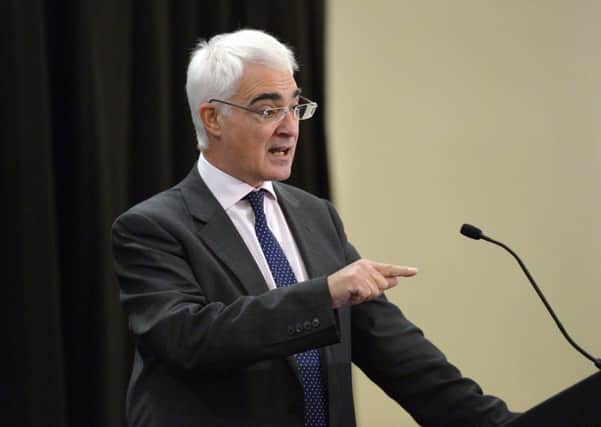Euan McColm: Better Together strategy may backfire


The late comic recalled Jack Palance’s murderous gunslinger Jack Wilson goading a shepherd into a fight. “Pick up the gun…” The shepherd cowers. “But I don’t want to pick up the gun, mister.”
“Pick it up…”
“I don’t want to. You’ll shoot me.”
Wilson is insistent, and when, eventually, the terrified man reaches for the weapon, he shoots him dead.
Advertisement
Hide AdAdvertisement
Hide Ad“You saw him,” Wilson tells horrified onlookers, “he had a gun.”
It’s a marvellous routine and no less powerful for the fact that the scene Hicks described doesn’t appear in the film.
Currently, in the fraught battle over the constitutional future of Scotland, there’s a shiny six-shooter lying at the feet of the No campaign. And First Minister Alex Salmond would very much like someone to pick it up.
Loaded in its chambers is a full discussion about what Better Together will offer Scotland in the event of a No Vote; the case not for the status quo but for a country making progress, being distinctive, while opting to remain within the United Kingdom.
For some time, now, the pro-independence campaign has been demanding from its opponents some detail of how they would shape a post-referendum Scotland. What would be the priorities? In what ways would Scotland be improved, made “fairer”? And, for the same length of time, the No campaign has avoided this discussion. It’s an understandable position – the promise of change recognises some need or, at least, desire for change. And, currently, only the SNP’s offer guarantees it.
The Better Together campaign is in a tricky position. Any “offer” of change after 18 September might begin to address broad public opinion, but nationalists would attack empty promises. They would argue – as they have in the past – that the No campaign was offering jam tomorrow, rather than anything of substance.
The Better Together narrative remains that Scottish independence is a minority interest and that voters, rather than wishing to fully explore its possibilities, would very much like the Scottish Government to focus its attention on other pressing matters, such as education, the NHS, and the economy.
Of course, the Yes campaign argues that real progress in these areas would come as a result of a vote in favour of removing Scotland from the United Kingdom.
Advertisement
Hide AdAdvertisement
Hide AdInstead of addressing the detail of how Scotland might move on from its desired referendum result, the Better Together campaign is now focussing its efforts on messages from the rest of the UK that it would like Scotland to stay in the “family of nations”.
This “please stay” campaign got off to a wobbly start last week when Prime Minister David Cameron made it part of his New Year address. A Tory PM, leading an austerity government lacks, after all, mass appeal in Scotland.
But there are to be others, I’m told, whose heartfelt pleas will touch the hearts of don’t-know Scots, bringing them back into No-voting fold. We shall see.
While Better Together tries to build this love-in, the SNP will keep pushing for the discussion about how unionists would make Scotland a better place in which to live and work.
It’s a neat twist to the debate which, so far, has set the nationalists’ emotional arguments against cold, hard (and sometimes usefully scary) “detail” from unionist campaigners. Now, Better Together wants to appeal to the heart while Salmond and his formidable team want to talk cold, hard “facts”.
With almost nine months to go until the referendum, it will surely be increasingly difficult for No campaign leader Alistair Darling to avoid picking up this gun. Both sides of the debate accept that relentlessly negative campaigning is far from a voter turn-on.
Polls tell us that Scots, whether we’ve considered any real detail or not, want “more powers” for Scotland. A unionist campaign that focuses solely on what would happen without any post-referendum change, doesn’t chime with public opinion. Scots expect something positive to come from the vote on the constitutional settlement, even if the current majority against independence holds strong until September.
For Salmond, the possibilities (or the potential promises) are endless: after voting Yes, Scotland may help itself to lots of this, plenty of that, and a great deal of the other. Darling and the No campaign have less to play with.
Advertisement
Hide AdAdvertisement
Hide AdCentral to Better Together’s argument is that the maintenance of the UK is in the very best interests of Scotland. Any argument in favour of substantial change within the settlement inevitably weakens that position. If the UK is so great, we might ask, why should we need to change the slightest thing about Scotland’s part in it?
The unionist block on a second question on the ballot paper on whether Scots would like a strengthened Holyrood – the devolution max option – was designed to thwart the SNP. A stark Yes/No question would scupper Salmond’s plans; “small c” conservative Scots wouldn’t dare risk the uncertainty of breaking the Union.
That may yet be the case. For unionists, it had better be, because it seems to follow that the lack of that second question puts pressure on them to give some clear answers on what they would do for Scotland in the event of either referendum result.
Salmond is a politician gifted in doing that vision thing. For as long as Better Together avoids discussing its own vision for Scotland, regardless of the referendum result, he has room to manoeuvre.
Darling might not want to pick up the gun but should Salmond’s post-Yes story gain momentum, he will have little choice.
But the risks of it backfiring are grave. «
Twitter: @euanmccolm